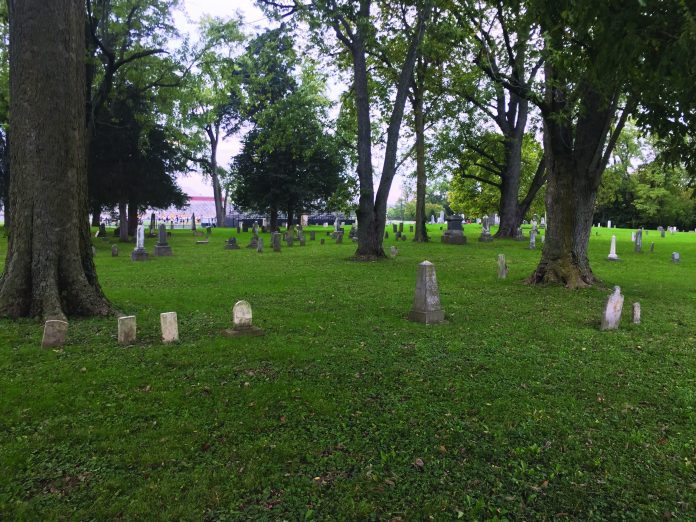
On Hanna Street, between the duplexes and Blackstock Stadium, is the Greencastle Township Cemetery. That’s its official name, but the cemetery has also been known as Hanna Street Cemetery, Blackstock Cemetery, and Old City Cemetery.
The cemetery’s care falls under the office of the Greencastle Township Trustee, currently occupied by Steve Butts. “We settle disputes with fences and weeds and things like that, but our main goal is the poor relief. Funds for folks that are in a little bit of trouble. And we do burials and things for folks that can’t afford to be buried,” Butts said. The cemetery is on federal land, meaning it has never been deeded or titled, so it is also part of the township’s responsibility.
Established in 1825, the cemetery is almost 200 years old, though it is no longer operational. Though Butts did not recall exactly when the cemetery closed operationally, he noted that there was one burial in 1989. “It was a dual-lot thing, and she was cremated. Well, in the state of Indiana, you can stack graves, only if it’s a cremation. So they were able to put her with her husband again,” he said.
The cemetery contains the graves of a number of interesting people, according to Butts, including a veteran of the War of 1812 who survived into the 1860’s and two unidentified Confederate soldiers. Soldiers such as these were transported to the Prisoner of War camps through the railroad, and according to Butts, if someone died in transit, the township they died in was responsible for burying them. According to a local tradition, Greencastle locals intentionally buried the Confederates “on the farthest northern part of the cemetery.” However, Butts said he did not know if the story was true, though, he said, “that’s what I’ve been told, and it kind of makes sense.”
The cemetery is open to visitors during daylight hours and they are welcome to leave flowers and other memorials to those buried there. Although some cemeteries have policies against leaving anything at the headstones, Butts said, “we encourage that [because] we don’t want anybody [to be] forgot[ten] any sooner than they have to.” A number of the headstones also have flags next to them, marking them as veterans. According to Butts, the American Legion used to bring out flags, but they haven’t for some time, and the effort is now left to individual community members and family members of the deceased.
Another interesting facet of remembrance at the cemetery was the tradition of leaving coins. On military graves, different coins hold different meanings: a penny means someone visited the grave, a nickel means they were at bootcamp with the deceased, a dime means they served in combat with the deceased, and a quarter means they were there when they passed. Some people also leave coins on non-military graves as an act of remembrance or leave other objects such as stones, statutes, decorations, and plants, in addition to the more ubiquitous flowers.
Although the cemetery itself is managed by the township, it is bordered by university property. “The university’s just been a wonderful neighbor,” Butts said. The university has helped build a new fence for the cemetery and been flexible to the cemetery’s needs. “Our flag pole had a problem, and Mr. Robinson had a crew come over and fix our flag pole for us. And that’s all appreciated [because] that all does come out of my budget.” One DePauw professor received permission to take rubbings of the grave stones a few years ago, and a student was able to use the cemetery in a video project.
Over the past few years, the township has been engaged in a restoration project. Butts says the restoration is “about 80% done.” They work to right headstones that have fallen over and repair ones that have cracked. Unfortunately, if markings have worn away or a headstone is completely lost, they aren’t always able to determine who is buried there. “We just cleaned that fence line out, this spring, and we found three more gravesites, but they’re indistinguishable,” Butts said. Although the library does have records of who is interned in the cemetery, the records don’t include specific plots.
The township plans to replace the rest of the old fence around the cemetery and to continue restoring the headstones. “It’ll actually never be done, just due to the fact that so many of the old stones are limestone, and limestone doesn’t stand up as good as like granite,” Butts added, “but as long as there’s a stone here, somebody’ll take care of it.”


